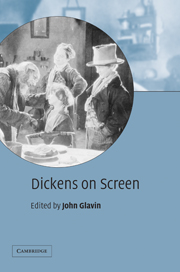Book contents
- Frontmatter
- Contents
- List of illustrations
- Notes on the contributors
- Acknowledgments
- Introduction
- Part I
- Part II
- 2 David Copperfield's home movies
- 3 David Lean's Great Expectations
- 4 Great Expectations on Australian television
- 5 Dickens's “The Signalman” and Rubini's La stazione
- 6 Bill Murray's Christmas Carols
- 7 Screen memories in Dickens and Woody Allen
- Part III
- Part IV
- Part V
- Index
- References
2 - David Copperfield's home movies
Published online by Cambridge University Press: 22 September 2009
- Frontmatter
- Contents
- List of illustrations
- Notes on the contributors
- Acknowledgments
- Introduction
- Part I
- Part II
- 2 David Copperfield's home movies
- 3 David Lean's Great Expectations
- 4 Great Expectations on Australian television
- 5 Dickens's “The Signalman” and Rubini's La stazione
- 6 Bill Murray's Christmas Carols
- 7 Screen memories in Dickens and Woody Allen
- Part III
- Part IV
- Part V
- Index
- References
Summary
David Copperfield is perhaps the most important exploration in Dickens's work of a character's conscious recollection of the past. It is also a deeply cinematic novel. This essay explores how David Copperfield narrates scenes of memory and retrospection in quasi-filmic ways, and how these ways are implicated in questions of male sexual identity, which it explores through various kinds of fetishism, voyeurism, sadism, and sexual transgression. David Copperfield tells the story of the production through narration of a particular kind of subject: male, bourgeois, heterosexual, monogamous. That process is, I want to argue, deeply cinematic. However, when we compare the novel with its most important film adaptation, we find a complexly disjunctive relationship between the modes of narration of the two media and their respective representations of masculinity and male desire.
It is striking how often in David Copperfield memory is presented not just as having a visual dimension (which would be unsurprising) but as constitutively visual and indeed cinematic. Remembering is seeing, many times in this book: “What else do I remember?”, asks David, “Let me see” (1983: 11). The second chapter of the novel, in which David's memories begin, is entitled “I observe” and, particularly in its opening pages, is concerned with what he sees: “the first objects that assume a distinct presence before me, as I look far back, into the blank of my infancy, are my mother … and Peggotty” (10).
- Type
- Chapter
- Information
- Dickens on Screen , pp. 29 - 38Publisher: Cambridge University PressPrint publication year: 2003
References
- 1
- Cited by



